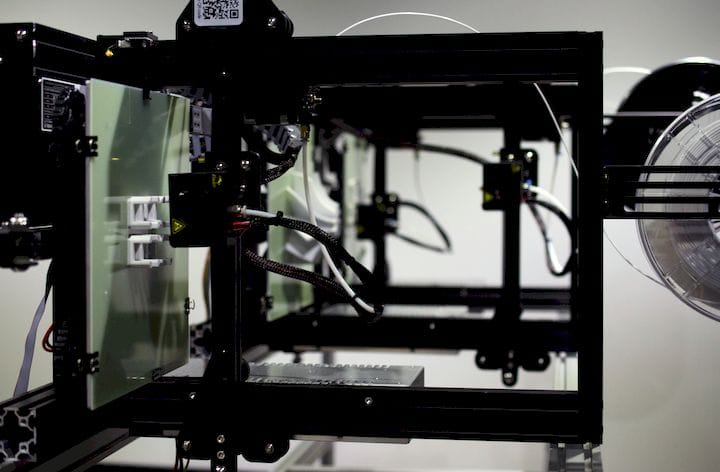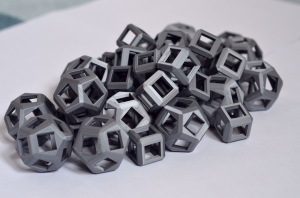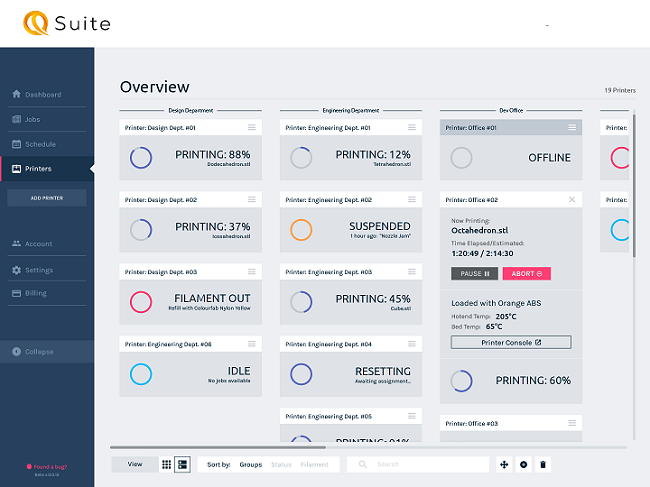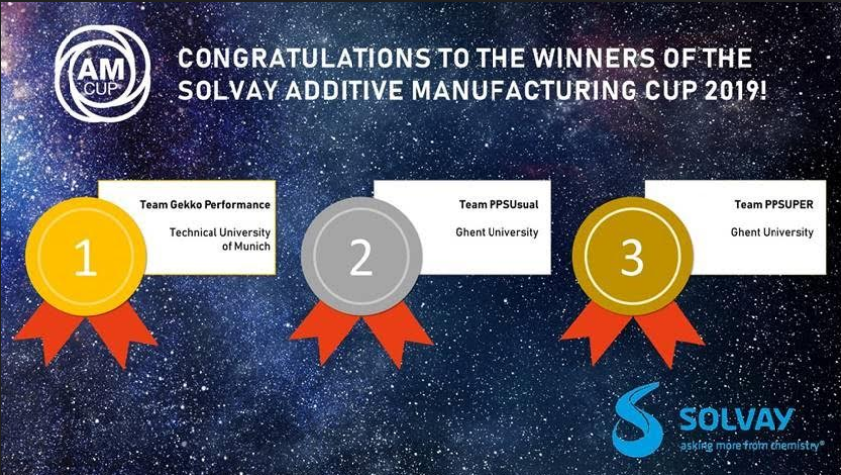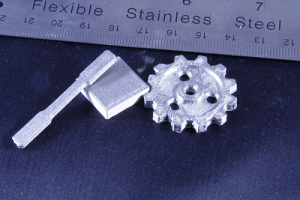Rapid 2019: Interview with Markforged’s Greg Mark On AI in 3D Printing
Markforged started by bringing an innovative continuous composites technology to 3D printing. Rather than try to be all things to all men, the firm had a strong initial automotive focus before branching out. Then the company surprised everyone by releasing a binder jetting metal 3D printer. Now with successive investment rounds, over 100 metal systems sold and new closed-loop technologies focussing on manufacturers the firm looks set for success. Now the company is putting out entire lines of systems with an X3, X5 and X7 on the market. The company also makes a complete suite of products including a sintering and washing station as well as its Eiger software. However, its up against HP, GE, Desktop Metal and new entrants in a very competitive space. How will Markforged compete? What makes this firm special and how can it win? Also, why should you choose to work with them?
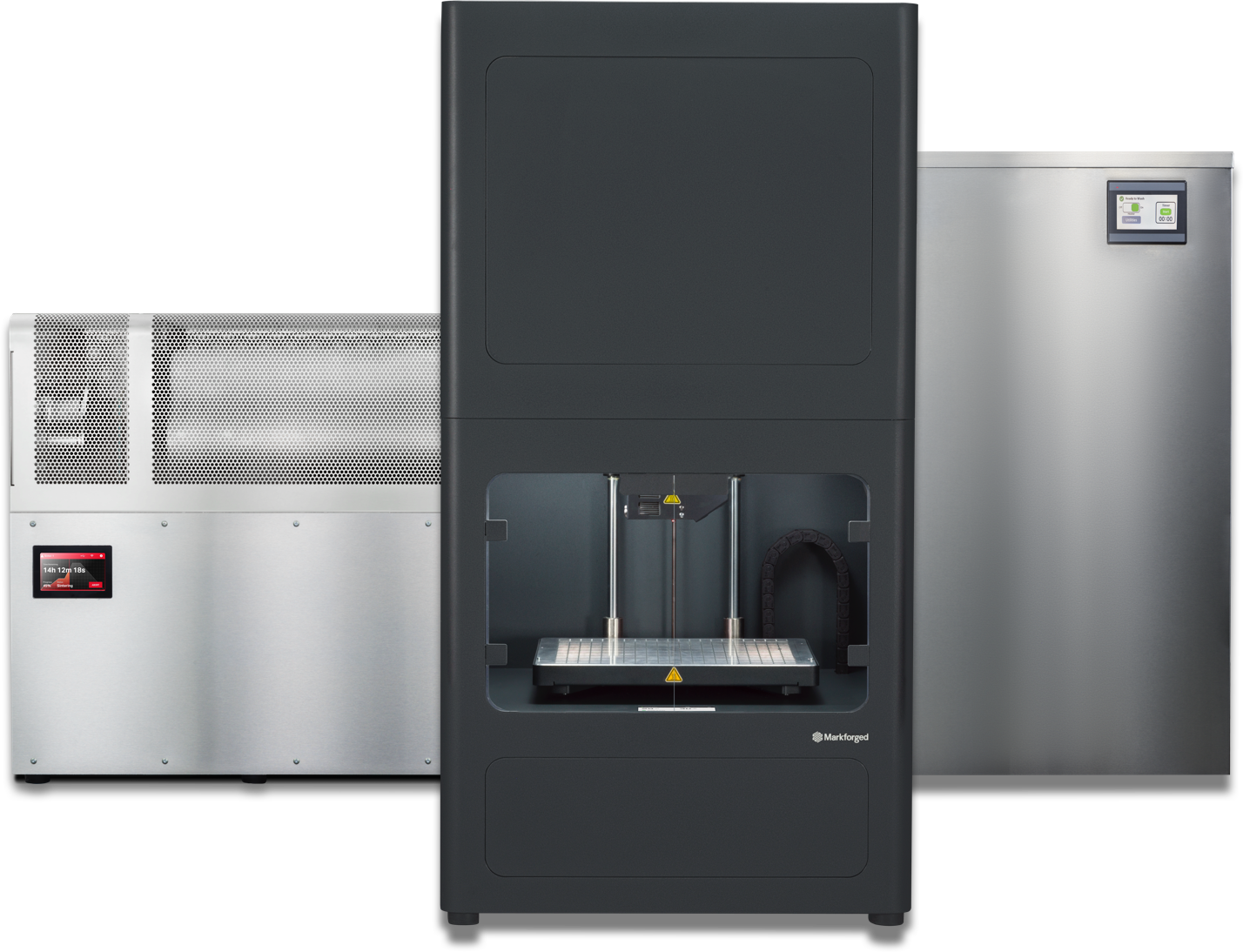
The Markforged systems can be ordered with washing/debinding and sintering stations from the firm.
At Rapid we sat down with the eminently bright Greg Mark, the founder of Markforged to talk about the future of his firm.
What makes Markforged special?
We are a software company, that produces parts. We create fully integrated systems consisting of software and materials. To make a production system, that is a combined system that can produce parts requires a different approach. For us to “end to end” ensure that our customers can make the right part we have to take into account all of the factors that influence the making of a part. The physics, the engineering, the code, your STL they all influence the properties of your final part. In order to account for those influences, we have to be systems people who design systems. Our people is, of course, the most special thing about us. We’ve managed to find a group of very enthusiastic, talented and intelligent people who are passionate about 3D printing. Together they make up Markforged. We are always looking for people who love 3D printing, who are systems people. Systems people that want to develop integrated systems that manufacture. There are a lot of companies making 3D printers, few make manufacturing systems. From the very beginning, software was an integral part of our manufacturing solution and with Blacksmith, the importance of software has only grown.
We also do things that no one else has done before. We were the first to 3D print continuous carbon fiber for example. We let you make high strength polymer parts through a low cost material extrusion process. Not only can you 3D print strong parts on the desktop we are letting you do this while fundamentally lowering the cost structure of these parts.

The X7 is an industrial polymer system for continuous fiber
What is adaptive manufacturing?
Up and until now machines go through the motion of making parts with no idea of what they’re making. Spindles move, toolheads cut but they have no awareness. They have no idea where they are and what they’re doing. Literally, they’re going through the motions. Machines will keep on running even if empty or cutting up air.
Now with Blacksmith we’re uniting your inspection equipment with the machine itself. Now for the first time, a machine can know what it is doing at any moment. What’s more, it can connect to an AI and learn about manufacturing. Our machine learning software is letting the machine rewrite its own code. The machine can now improve itself. This will improve reliability and repeatability for manufacturing. The machine can now learn “How do offsets work?” for example.
What will Blacksmith do for manufacturers?
Blacksmith lets manufacturers create dependable parts the first time, every time. Now we’re closing the loop by integrating part scanning, printer hardware, and software. This means that you’ll know that you have the right material, in the right places, and the right shape at the right moment. This improves part outcomes and locks in repeatability when you go into production. Blacksmith compares a design to a 3D scanned part and then adapts the process to create in spec parts.
With Blacksmith we’ve made an autopilot for manufacturing. Rather than waste material and time we cut waste and accelerate time to market. This is not just a 3D printing solution we aim to connect your entire factory to Blacksmith.
So it’s a learning algorithm?
It is a learning algorithm that encompasses all of the relevant data that you need to make an in-spec part. The same way that we train application engineer, we train the AI. For many of our customers’ lack of qualified 3D Printing staff reduces their adoption speed. They have Mary and she understands 3D printing but she will be the only one in the organization. With Blacksmith part of the knowledge that used to only be in Mary’s head will now be in the cloud, accessible to your machines.
The steep learning curve that people have had to go through to really use 3D printing for manufacturing is now reduced. The machine, the factory is on autopilot. Through now being able to predict part outcomes and act accordingly Blacksmith lets companies adopt 3D printing at an accelerated rate. Staffing is now less of a bottleneck and the company can get to production quicker.

The Onyx two is a desktop system that can make continuous carbon fiber parts.
In binder jetting metals, the sintering step has always been problematic. How are you trying to solve this?
We’re letting the machine change its own code to make their own part. Blacksmith can now predict parts and defects. We don’t use a linear scale factor. Blacksmith intelligently alters the part to get the outcome that you need. In this way, we can have a system that will continuously learn and improve to get the optimal output for manufacturing.
3DQue Introducing QPoD & QSuite at RAPID 2019: Enabling Autonomous 3D Printing Mass Production Capabilities
Today in Detroit, this year’s RAPID + TCT kicked off in the Cobo Center. We’ve already been reporting on plenty of news from the show, with lots more to come in the days ahead. Canadian company 3DQue Systems Inc., which automates FFF and FDM 3D printing for mass production, will be launching two technologies at the event this week: QSuite and QPoD.
First, a little background…the company was founded just last year by finance expert Steph Sharp and 18-year-old inventor and 3D printing whiz 18-year-old Mateo Pekic, who began 3D printing small part quantities in 2016. Pekic needed to find a way to remove parts from the print bed and start the next job remotely, and after lots of research and testing, has now been running his own 3D printers – with full automation – for more than two years.
“Until now, plastic 3D printing has failed to meet today’s manufacturing needs due to the high cost of part removal and lack of end-to-end automation. Working from his basement, Mateo Pekic has been able to solve a problem that has stumped some of the world’s leading experts in materials science, engineering and innovation by automating plastic 3D printers to safely produce complex plastic parts at scale,” said Sharp, who is also the CEO of 3DQue.
 Pekic spoke with Sharp, a local mentor for entrepreneurs, and asked her to run the business with him; 3DQue was founded just days after Pekic’s 18th birthday. The company has truly made plastic 3D printing competitive with traditional manufacturing, as it offers solutions to some of the major problems when it comes to scaling the technology, such as unit cost, autonomous part removal, and automated production.
Pekic spoke with Sharp, a local mentor for entrepreneurs, and asked her to run the business with him; 3DQue was founded just days after Pekic’s 18th birthday. The company has truly made plastic 3D printing competitive with traditional manufacturing, as it offers solutions to some of the major problems when it comes to scaling the technology, such as unit cost, autonomous part removal, and automated production.
When I first saw an image of the QPoD, I was positive it was oriented wrong, until I read the release more closely. The plastic high-volume 3D printing mass production unit, powered by the company’s automation QSuite, has a vertical build platform.
This could actually be a real game changer. The efficient, compact, 24/7 production-on-demand unit has a total of nine 3D printers in a 12 sq ft 3×3 array. An 8-day field trial was conducted on the autonomous platform in January, and the QPoD printers were able to successfully produce 25 x 25 x 25 mm switch cube frames at a rate that would be equivalent to 100,000 parts a year: a production capacity of over 8,000 parts/sq ft.
The platform has internal conveyors and collection bins for true autonomous 3D printing, at unit costs that are competitive with injection molding. With QPoD, there’s no need for outsourcing, which helps reduce inventory levels, costs, the environmental footprint, and lead times.
The QPoD is driven by QSuite, which automates 3D printers all the way from upload of the design to delivery of the parts. This end-to-end automation upgrade negates manual, time-consuming tasks like enterprise scheduling, 3D printer restart, and parts removal. The suite includes several modules, including calibration, material removal, and matching the next print job to the current 3D printer configuration.
QSuite mass produces high-quality plastic parts in a continuous loop without the need for dedicated operators, and reprioritizes jobs based on changing parts or deadlines. The suite doesn’t require any glue, tape, or robotics for autonomous part removal, and uses real-time reporting and management data to give users complete control from remote locations.
At RAPID this week, 3DQue will be offering live, hands-on demonstrations of the innovative QPoD. Not only has the cover been removed from the platform so attendees can get a good look inside, but you can also book a hands-on demonstration of the automated part ordering system at the company’s booth #1765. You can choose the part, material, color, and quantity, then watch how it’s uploaded into the queue and matched with the correct printer. Once the part is printed, attendees will be able to see it automatically delivered to the collection area and pick it up.
Additionally, don’t miss the Innovation Auditions at RAPID today from 1:30-2:30, as Pekic will be competing for the chance to present 3DQue at tomorrow morning’s keynote presentation.
Starting in July, QSuite capabilities will be available for license to end users on a pay-for-use basis starting at $1 an hour per printer (lower hourly rate for high volume users). Booking is also currently open for the QPoD platform, with installations slated to take place between June-December 2019 for the introductory price of $45,000. Each on-demand production unit comes with QSuite, automated part delivery, control panel, and nine 3D printers.
Discuss this story and other 3D printing topics at 3DPrintBoard.com or share your thoughts below.
[Images provided by 3DQue]
RAPID 2019: BigRep to Unveil New-Generation STUDIO G2 Large Format 3D Printer
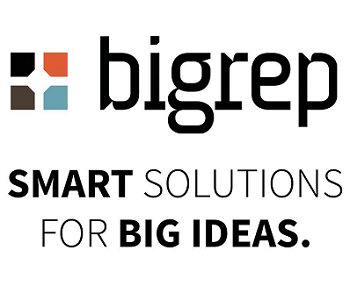 News is already flooding in regarding the Rapid+TCT event in Detroit, Michigan being held from May 20-23. Berlin’s BigRep will be attending in full-force, ready to unveil the BigRep STUDIO G2, a new generation 3D printer joining the STUDIO lineup.
News is already flooding in regarding the Rapid+TCT event in Detroit, Michigan being held from May 20-23. Berlin’s BigRep will be attending in full-force, ready to unveil the BigRep STUDIO G2, a new generation 3D printer joining the STUDIO lineup.
The STUDIO G2, available to order now, 3D prints ‘engineer-grade’ materials while also encompassing all the same features of the original STUDIO hardware created for fabricating large parts.
BigRep’s STUDIO 2 3D printer was created for industrial applications but is suitable for everyday use, offering the following new features:
- Unmatched speed and resolution in large format 3D printing
- Ergonomic design
- Height of 1765 mm
- Fully enclosed, insulated build envelope (500 mm x 1000 m x 500 mm)
- Fast heating print bed reaching 100°C
- Temperature-controlled filament chamber
- Dual extruder with two 0.6 mm ruby nozzles
- Layer heights as little as 0.1 mm for abrasive engineering-grade materials like PA6/66
“We are excited to host the world premiere of the STUDIO G2 at North America’s most influential AM event – RAPID+TCT. We believe that both customers already relying on the original machine and new ones will appreciate the many advanced features of the STUDIO G2,” said BigRep CBO, Frank Marangell.
BigRep will be releasing other 3D printing materials (also engineering grade) in the future, to include carbon/glass fiber composites, and ASA. The STUDIO G2 will also feature the new proprietary BigRep BLADE slicer software, which BigRep states will offer accurate printing times and tools for improved production such as material use calculations.
“The new generation STUDIO G2 is a great addition to our expanding industrial portfolio of large-format printers. Based on proven, successful technology, the STUDIO G2 is upgraded with key features that industrial users need,” said BigRep CEO, Stephan Beyer, PhD. “We’ve built it for printing with the abrasive, engineering-grade materials that the industry demands in a next-level, space-saving printer for large-format parts.”
The BigRep Pro will also be on-site, running BigRep’s MXT® Metering Extruder Technology, and a state-of-the-art Bosch Rexroth motion control system. Designer Marco Mattia Cristofori will also be at the show to present NERA, a completely 3D printed e-motorbike that was created in only 12 weeks.
Founded in 2014, BigRep also has offices in Boston and Singapore. Catering to engineers, designers, and manufacturers, they also partner with Bosch Rexroth, Etihad Airways and Deutsche Bahn. Key investors are BASF, Koehler, and Klöckner and Körber. We have followed the German company extensively, from the unveiling of the BigRep ONE to the PRO and the EDGE 3D, along with following their extensive partnerships and contributions to additive manufacturing research.
What do you think of this news? Let us know your thoughts! Join the discussion of this and other 3D printing topics at 3DPrintBoard.com.
[Source / Images: Big Rep Press Release]
Join the RAPID + TCT OPENING EVENT & THOUGHT LEADERSHIP PANEL DISCUSSIONS May 20th
North America’s premier Additive Manufacturing Event RAPID + TCT will soon start on May 20th. You can still attend by registering here. The RAPID + TCT event will bring together 3D printing and Additive Manufacturing professionals from all over the world. Experienced folks from academia, industry, vendors and those new to the industry will come to Detroit from all over the world. Congregating at RAPID + TCT, this eclectic and well-informed group will exchange views, information, learning, and data in an unencumbered way.
The sharing starts with the Opening Event, which will take place on May 20th from 3 pm to 5 pm. This event brings together thought leaders, as well as provides practical information for attendees. Programmed by SME’s Additive Manufacturing Technical Community advisors, who are key members of the industry, you can expect to learn and be informed here.
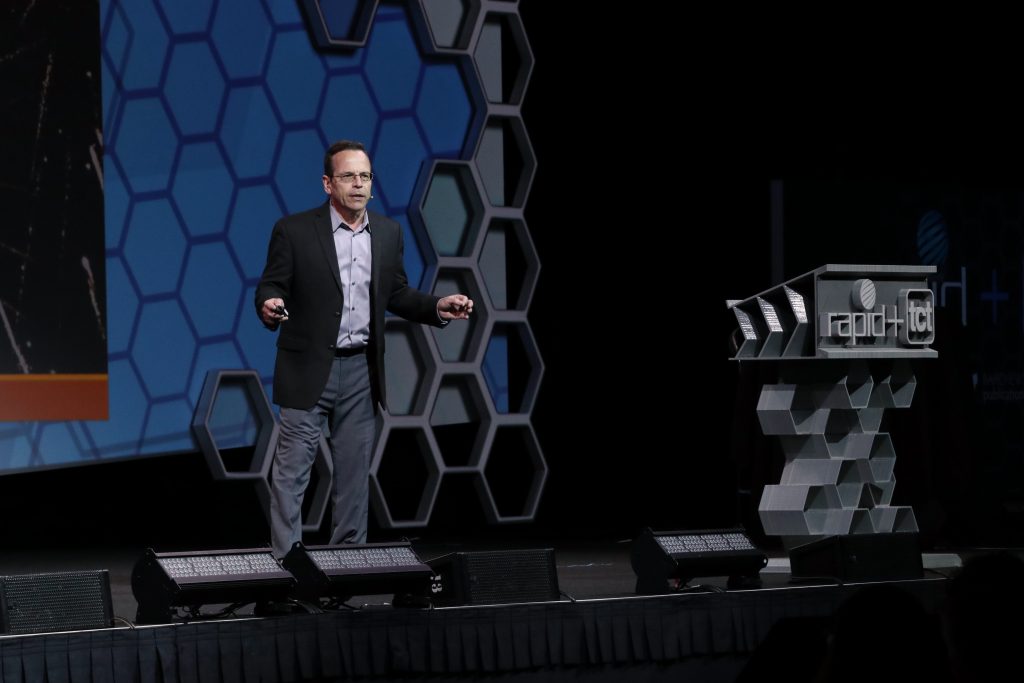
The highlights will be:
-
- Opening Keynote Presentation by Carbon and Riddell
- Todd Grimm will present “What’s New at RAPID + TCT”, giving you an overview of the newest products in 3D printing and 3D scanning.
- SME’s Technical Community Advisor – Guide to the Show: Make the most of your RAPID + TCT Experience
- SME’s AM Industry Award Winners
- Opening Reception – Held immediately after the Opening Event, network with industry experts and influencers. Open to all RAPID + TCT attendees and exhibitors.
In addition to making your days at RAPID + TCT more effective with practical guides to the show, the cutting edge applications of 3D printing in sports will also be covered by Riddell and Carbon.
“I’m honored to be delivering the keynote at RAPID + TCT this year,” said Erika Berg, Head of Application Development, Carbon. “The RAPID + TCT stage is the perfect platform for reaching the most important thought leaders and industry movers in additive manufacturing. I’m excited to share how Carbon and Riddell joined teams to produce the first-ever, digitally printed helmet liner for the SpeedFlex Precision Diamond football helmet.”
Monday, May 20
Carbon and Riddell: Bringing Innovation to Head Protection
Erika Berg, Head of Application Development, Carbon & Vittorio Bologna, Research & Development Manager, Riddell
- Carbon and Riddell have partnered to bring customized, digital design innovation to head protection through Riddell’s new Diamond helmet platform.
- The new platform features a 3D printed lattice liner that is digitally manufactured using Carbon’s proprietary Digital Light Synthesis
 (DLS
(DLS ) technology.
) technology. - Berg and Bologna will discuss the recent breakthroughs in software, hardware and materials that make the Diamond platform possible, including the new L1 printer and custom resin material. Berg will highlight the product development journey between Carbon and Riddell that led to this impressive new helmet.
Thought Leadership Panel Discussions
Subsequently, there will be even more time for learning with a Thought Leadership panel on each day Tuesday-Thursday. Terry Wohlers will lead a storied panel who will bring news from the frontlines of adopting Additive Manufacturing.
Tuesday, May 21, 2019 | 12:30 pm – 1:30 pm
Trends that Will Impact Your Future

MODERATOR: Terry Wohlers, Principal Consultant and President, Wohlers Associates, Inc.
PANELISTS:
John Dulchinos, Vice President, Digital Manufacturing, Jabil, Inc.; Cynthia Flanigan, PhD, Chief Engineer, Vehicle Research & Technology, Research and Advanced Engineering, Ford Motor Company; Donald Godfrey, Engineering Fellow – Additive Manufacturing, Honeywell Aerospace; Markus Seibold, VP Additive Manufacturing, Gas and Power, Siemens AG
- This star panel will discuss:
- The importance of design for additive manufacturing
- Justifying the cost of AM for production applications
- Challenges associated with post-processing and post-process automation
- Scaling AM technology across multiple locations
- Managing growth
- AM knowledge and skills development
- Anticipating future developments.
Another panel will see the CEO of 3D Systems, Vyomesh Joshi, discuss manufacturing productivity and the industrialization of AM.
Wednesday, May 22, 2019 | 12:30 pm – 1:30 pm
Leveraging Additive Manufacturing for Enhanced Productivity: The Manufacturer’s Perspective
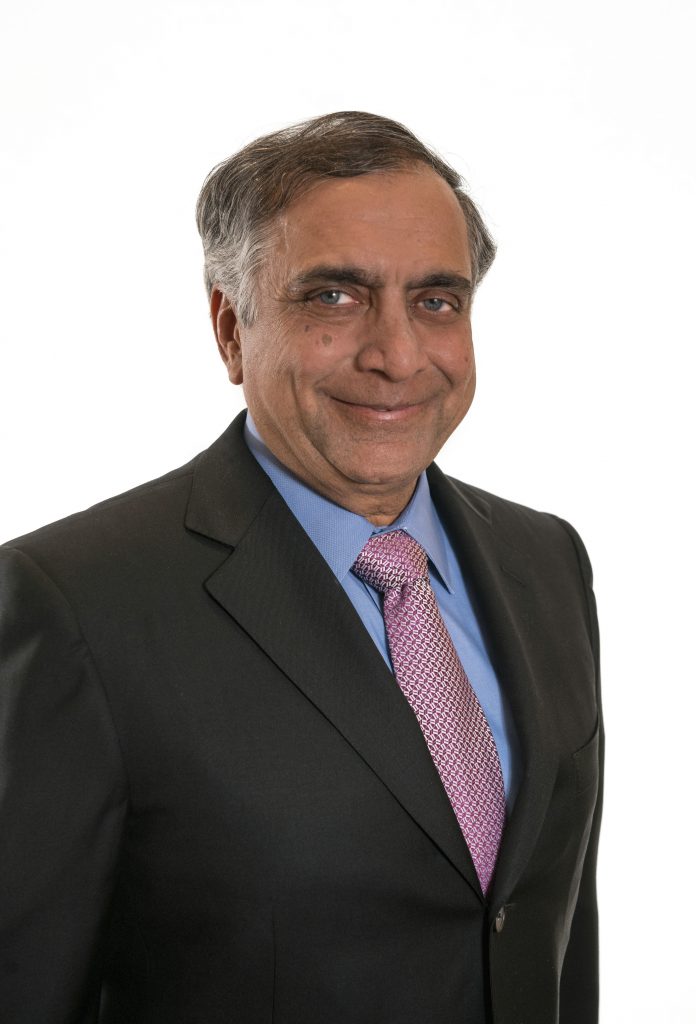
MODERATOR: Vyomesh Joshi – President and CEO, 3D Systems
- Today, new marketplace demands are pushing the industry to increase speed and agility, and competitive pressures require rapid product development and shorter production cycles.
- During this session, 3D Systems’ President and CEO, Vyomesh Joshi, will moderate a conversation with customers to explore how the industrialization of additive manufacturing is allowing their respective companies to respond to these demands.
Automotive Day Panel
The next day there will be another event that will be very relevant to Detroit. The Automotive Day on Thursday, May 23 will showcase the advancements in automotive additive manufacturing and discuss what the future holds. A key part of this is a panel hosted by ORNL’s Lonnie Love.
Oak Ridge National Laboratory has done some incredible work in developing and implementing completely new 3D printing technologies. Lonnie Love is the Group Leader at Oak Ridge in charge of Automation, Robotics and Manufacturing there will moderate a panel on the realities of Additive Manufacturing. He will be joined by panelists from Northrop Grumman, GM, Penske Racing, LIFT and the University of Michigan.
Thursday, May 23, 2019 | 12:30 pm – 1:30 pm
Additive Manufacturing: What’s Real, What’s Not, What’s Next

MODERATOR: Lonnie Love, PhD, Group Leader – Manufacturing Systems Research Group, Oak Ridge National Laboratory
PANELISTS: Eric Barnes, Fellow, Additive Manufacturing, Northrop Grumman; Tyson W. Brown, PhD, Lab Group Manager, Additive Manufacturing Research, General Motors Global R&D; Matt Gimbel, Production Manager, Penske Racing; Alan Taub, PhD, LIFT Senior Technical Advisor, Professor, Material Science & Engineering and Mechanical Engineering, University of Michigan
- As part of Thursday’s Automotive Day, leading subject matter experts in additive manufacturing representing the automotive and aerospace industries will join Lonnie Love for a thought leadership panel discussion in the afternoon.
- Discover how additive manufacturing can create opportunities that will drive performance and growth.
We hope that you have time in your busy schedules to come to Detroit to learn from and engage with the Additive Manufacturing industry. We wish you a warm welcome; register here.
Germany’s Henkel Acquires Molecule Corp., Strengthening 3D Printing & Materials Division
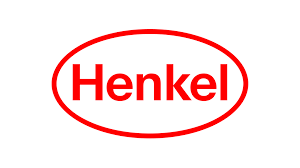 In another dynamic acquisition regarding the global progress of 3D printing and additive manufacturing technology, Henkel has just announced the purchase of Molecule Corp., headquartered in Concord, CA, near the San Francisco Bay area. This addition to the Henkel portfolio should propel them further into the technology realm as they continue to find success in their plan for making ‘targeted acquisitions,’ along with fortifying their additive manufacturing processes for production of strong, functional parts made from a variety of materials.
In another dynamic acquisition regarding the global progress of 3D printing and additive manufacturing technology, Henkel has just announced the purchase of Molecule Corp., headquartered in Concord, CA, near the San Francisco Bay area. This addition to the Henkel portfolio should propel them further into the technology realm as they continue to find success in their plan for making ‘targeted acquisitions,’ along with fortifying their additive manufacturing processes for production of strong, functional parts made from a variety of materials.
The technology and expertise built thus far by the Molecule Corp. team will also complement Henkel’s current strategies for research and development of new materials and techniques such as inkjet printing. Although they have locations around the globe, Henkel is headquartered in Düsseldorf, Germany. They currently employ over 50,000 people today, but are still run as a family business that was founded on ‘strong entrepreneurial spirit’ in 1876. Creating value for their customers is priority, but their focus remains on offering sustainability to future generations as they continue to manage and create new materials from renewable raw resources—and this is where 3D printing enters the picture.
“Molecule Corp. and Henkel are an excellent fit,” says Philipp Loosen, head of 3D Printing at Henkel. “Molecule’s strong 3D printing and inkjet resin technologies and digital development capabilities perfectly complement and strengthen our materials portfolio and build on our approach to offer a comprehensive range of customized additive manufacturing solutions.”
 Molecule Corp. currently offers a wide array of 3D printing solutions related to applications like:
Molecule Corp. currently offers a wide array of 3D printing solutions related to applications like:
- Medical devices
- Aerospace
- Automotive
- Consumer goods
- Industrial materials
“Molecule’s technology and engineering center in California also broadens our global 3D printing footprint. We now provide 3D printing support to our customers in all major regions around the world,” adds Michael Todd, head of Innovation at Henkel Adhesives Technologies.
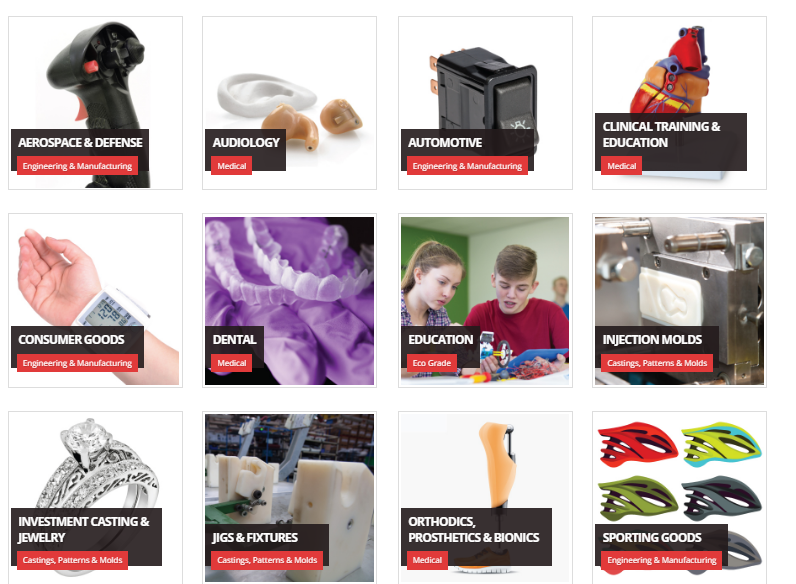
Molecule Corp. is currently making an impact in many different applications with 3D printing (Image: Molecule Corp.)
If you are attending the upcoming Rapid + TCT show (held in Detroit, Michigan from May 20-23), check out the Henkel booth where the Molecule Corp. team will also be present from May 21-23 — along with over 375 other exhibitors, many of whom are also involved in 3D printing and related technologies.
“We are excited to join Henkel,” says Ken Kisner, founder and president of Molecule Corp. “Henkel’s customer centered approach along with our combined product portfolio will help key industries accelerate the speed of innovation and move 3D printing from prototyping to digital manufacturing.”
Although 3D printing was created decades ago to offer engineers a faster and more streamlined method of prototyping, once the technology hit the mainstream users became intent on making objects and customized parts to suit an infinite number of industrial and creative projects worldwide. The possibilities are there for changing the marketplace forever with the ability to produce one-of-a-kind, highly tailored products for discerning consumers, but we are also curious to see what role 3D printing will play in mass manufacturing as companies like 3D Systems and Stratasys bring forth the tools.
What do you think of this latest news regarding innovative companies in the material resources and technology world? Let us know your thoughts! Join the discussion of this and other 3D printing topics at 3DPrintBoard.com.

A 3D printed medical model that could be used for diagnosing, training, and more (Image: Molecule Corp.)
[Source: Henkel]
Solvay Announces Winners of 2019 Solvay AM Cup, First Place Winners Take $10K Home
 It’s that time of year again, as Italy’s Solvay announces winners for what seems to have become a yearly tradition with their AM Cup. For 2019, students were at the ready, and given an industrial task as they were challenged to use Radel® PPSU AM-ready filament for creating an ASTM D638 Type V size tensile bar in the z-axis, along with a wavy-shaped pressure pipe.
It’s that time of year again, as Italy’s Solvay announces winners for what seems to have become a yearly tradition with their AM Cup. For 2019, students were at the ready, and given an industrial task as they were challenged to use Radel® PPSU AM-ready filament for creating an ASTM D638 Type V size tensile bar in the z-axis, along with a wavy-shaped pressure pipe.
While it may seem like an easy challenge to be given an assignment to print out a couple of parts, there was much more to it than that; in fact, students from three continents participated in this contest, with 35 student teams from 32 universities. Solvay’s ultimate goal in initiating the 2019 Solvay AM Cup was to highlight the impact 3D printing materials can have on different applications today due to the high performance of parts—and the availability of different materials and methods. Solvay’s focus was for the students to explore the disruptive technology and learn more about ‘the art of the possible.’
The teams were judged on their collective enterprise in making the parts, judged on:
- Creativity in 3D printing
- Maximum dimensional accuracy
- Mechanical properties
- Performance in burst pressure tests and translucency
Each team was provided with a spool of Radel® polyphenylsulfone (PPSU) AM filament and sent on their way to make plans for winning the competition. Those who were successful in their mission have just been announced:
- First place – The Gekko Performance Team from Technical University (Munich)
- Second place – PPSUsual from Ghent University (Belgium)
- Third place – PPSUPER (Belgium)
“The team secured the first prize due to its ability to achieve 100 percent z-axis strength in the Type V size tensile bar and its wavy pipe showed overall dimensional accuracy, surface uniformity, and a remarkable mechanical performance by enduring a burst pressure test of 1,400 psi (96.5 bar) for two hours,” states Solvay in their press release, also commenting that there was very little separating the teams who won second and third place regarding performance in strength and ductility of their parts.
The winners won $10,000, $5,000, and $3,000, respectively, with the idea that these funds would be well-invested in activities related to higher learning, or ‘societal or entrepreneurial’ endeavors. The 3D printed parts they submitted for the challenge will be on display at the Rapid + TCT show in Detroit, MI (Booth #747) from May 21-23.
“It was inspiring to see the various approaches to solving the challenges of fused filament fabrication (FFF) such as bed adhesion and chamber temperature management. The winning team demonstrated once more that 3D printed parts can virtually match the performance and quality of conventional injection molded parts, provided material, hardware, and process are optimized together,” said Ryan Hammonds, R&D platform manager for Solvay’s Specialty Polymers global business unit and president of the AM Cup Jury.
“We look forward to sharing with our customers the benefits gained from this edition of the Solvay AM Cup for 3D printing the best possible PPSU parts for applications in various industries such as aerospace, healthcare and industrial.”
Along with inspiring students to explore the infinite opportunities available with 3D design and printing, Solvay has continued their momentum, offering strong opinions on the future of 3D printing, expanding materials within their manufacturing processes, and entering into dynamic partnerships. What do you think of this news? Let us know your thoughts! Join the discussion of this and other 3D printing topics at 3DPrintBoard.com.
[Source / Images: Solvay]
3D Printing News Briefs: April 21, 2019
We’re beginning with an aerospace 3D printing story in 3D Printing News Briefs today, then moving on to news about some upcoming industry events and finishing with a little business. Launcher tested its 3D printed rocket engine on an important date in history. DuPont will be introducing new semi-crystalline 3D printing products at RAPID + TCT, and Nanofabrica has offered to 3D print micro parts at no cost for interested companies attending the annual euspen conference. Ira Green Inc. used Rize technology to transform its production process, GOM is now part of the Zeiss Group, and the Ivaldi Group received its ISO 9001:2015 certification.
Launcher Tests 3D Printed Rocket Engine
 New York startup Launcher, which uses EOS technology to create 3D printed components for metal rocket engines, has completed many firing tests with these parts over the last year and a half. Recently, on the anniversary of the date the first human left Earth to go into space, the startup announced the results of the latest test.
New York startup Launcher, which uses EOS technology to create 3D printed components for metal rocket engines, has completed many firing tests with these parts over the last year and a half. Recently, on the anniversary of the date the first human left Earth to go into space, the startup announced the results of the latest test.
Launcher’s founder and CEO Max Haot posted on his LinkedIn account that the E-1 copper bi-metal rocket engine, which was 3D printed on the EOS M290, broke the startup’s combustion pressure record at 625 psi, mr 2.5. It will be interesting to see how the engine performs on its next test.
DuPont to Introduce New Semi-Crystalline Materials
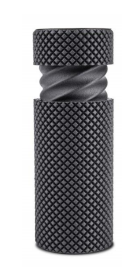 At next month’s RAPID + TCT in Detroit, DuPont Transportation & Advanced Polymers (T&AP), a DowDuPont Specialty Products Division business, will be launching an expansion to its 3D printing portfolio: advanced, high-performance semi-crystalline materials, which will give customers more manufacturing agility and open new opportunities to lower costs while increasing production.
At next month’s RAPID + TCT in Detroit, DuPont Transportation & Advanced Polymers (T&AP), a DowDuPont Specialty Products Division business, will be launching an expansion to its 3D printing portfolio: advanced, high-performance semi-crystalline materials, which will give customers more manufacturing agility and open new opportunities to lower costs while increasing production.
Jennifer L. Thompson, Ph.D., R&D programs manager for DuPont T&AP, will be presenting a technical paper about the materials during the event as part of the Material Development and Characterization session. During her presentation at 10:15 am on May 23rd, Thompson will discuss alternative 3D printing methods, like pellet extrusion modeling, in addition to highlighting new engineering materials and talking about tailored material testing programs. Thompson and other DuPont employees will be at DuPont T&AP’s booth #552 at RAPID to answer questions about the company’s 3D printing materials.
Nanofabrica Offers Free 3D Printing Services for euspen Attendees
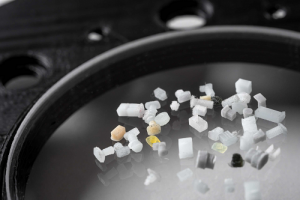 Last month, Israeli 3D printing startup Nanofabrica announced the commercial launch of its micro resolution 3D printing platform. In order to show off the system’s abilities to potential customers, Nanofabrica has made an enticing offer to attendees at next month’s euspen conference and exhibition in Spain: the startup will print parts for interested companies at no charge. Then, the parts printed on the new micro AM platform will be presented to them at the event, which focuses on the latest technological developments that are growing innovation at the micron and sub-micron levels.
Last month, Israeli 3D printing startup Nanofabrica announced the commercial launch of its micro resolution 3D printing platform. In order to show off the system’s abilities to potential customers, Nanofabrica has made an enticing offer to attendees at next month’s euspen conference and exhibition in Spain: the startup will print parts for interested companies at no charge. Then, the parts printed on the new micro AM platform will be presented to them at the event, which focuses on the latest technological developments that are growing innovation at the micron and sub-micron levels.
“It’s quite simple really. We believe that the best way to prove what our AM system can do, how high the resolution and accuracy of the parts we make are, is to manufacture parts for attendees,” Jon Donner, the CEO of Nanofabrica explained. “Registered attendees are welcome to send us their files, and we will examine and print them. That is how confident we are that you will be amazed by the capabilities of our system, and this we feel will mean that we can forge meaningful relationships with manufacturers that will endure into the future.”
Rize 3D Printing Transformed Company’s Production Process
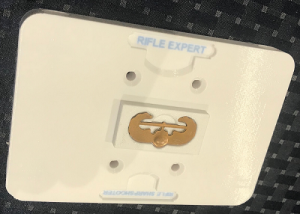 Rhode Island-based IRA Green Inc. (IGI), a full-service manufacturer and distributor of unique uniform items earned and worn by military personnel around the world, recently turned to RIZE and its 3D printing capabilities in order to manufacture small fixtures for its tool shop. The company’s products are in high demand, but lead times were growing longer due to bottlenecks and 8 hours of work for each $300 fixture. Precision is also important for these parts, which is why IGI decided to turn to the RIZE ONE hybrid 3D printer. According to a new case study, IGI’s design team uses the printer every day to manufacture accurate fixtures in just 50 minutes for $2.00 a part. Using the RIZE ONE, which has the unique capability of adding ink markings to parts for verification, the company has been able to standardize its nails and molds, which helped lead to an ROI in less than five months.
Rhode Island-based IRA Green Inc. (IGI), a full-service manufacturer and distributor of unique uniform items earned and worn by military personnel around the world, recently turned to RIZE and its 3D printing capabilities in order to manufacture small fixtures for its tool shop. The company’s products are in high demand, but lead times were growing longer due to bottlenecks and 8 hours of work for each $300 fixture. Precision is also important for these parts, which is why IGI decided to turn to the RIZE ONE hybrid 3D printer. According to a new case study, IGI’s design team uses the printer every day to manufacture accurate fixtures in just 50 minutes for $2.00 a part. Using the RIZE ONE, which has the unique capability of adding ink markings to parts for verification, the company has been able to standardize its nails and molds, which helped lead to an ROI in less than five months.
IGI’s Manufacturing Manager, Bill Yehle said, “Implementing RIZE 3D printing as part of a strategic process shift has completely transformed our production process.
“We have realized an 80% time savings in setup and changeover alone using RIZE and virtually eliminated errors.”
ZEISS Group Acquires GOM
 In an effort to expand its industrial metrology and quality assurance portfolio, the ZEISS Group, a technology enterprise operating in the optics and optoelectronics fields, has acquired GOM, which provides hardware and software for automated 3D coordinate measuring technology. By combining GOM’s optical 3D measuring technology with its own products, ZEISS could expand market access, and create new opportunities, for its Industrial Quality & Research segment. Once the transaction is complete, which should happen soon, GOM will become part of this ZEISS segment, while the legal form of its companies in Germany and elsewhere will stay the same. The financial details of the transaction will not be discussed publicly.
In an effort to expand its industrial metrology and quality assurance portfolio, the ZEISS Group, a technology enterprise operating in the optics and optoelectronics fields, has acquired GOM, which provides hardware and software for automated 3D coordinate measuring technology. By combining GOM’s optical 3D measuring technology with its own products, ZEISS could expand market access, and create new opportunities, for its Industrial Quality & Research segment. Once the transaction is complete, which should happen soon, GOM will become part of this ZEISS segment, while the legal form of its companies in Germany and elsewhere will stay the same. The financial details of the transaction will not be discussed publicly.
“Our growth strategy expressly mentions the targeted acquisition of highly innovative solutions, technologies and companies, which can reach their full potential as part of the ZEISS Group. By acquiring GOM and thereby expanding our solutions portfolio, we are bolstering the leading position of our Industrial Quality & Research segment and will be able to offer even better solutions for our customers. This is entirely in keeping with our corporate strategy, which is focused on our customers’ success,” said Dr. Michael Kaschke, President & CEO of ZEISS.
Ivaldi Group Awarded ISO 9001:2015 Certification
 California startup Ivaldi Group, which uses 3D printing and metal fabrication solutions to provide in-port parts on-demand services for the maritime, mining, offshore, and construction industries has become ISO 9001:2015 certified in less than ten months. This standard, which is certifies quality managements systems that focus on customer satisfaction, continuous improvement, and active involvement of employees and management in a process-based approach, is the first step in the certification process that’s required to certify specific products. This proves Ivaldi’s commitment to constantly improving itself.
California startup Ivaldi Group, which uses 3D printing and metal fabrication solutions to provide in-port parts on-demand services for the maritime, mining, offshore, and construction industries has become ISO 9001:2015 certified in less than ten months. This standard, which is certifies quality managements systems that focus on customer satisfaction, continuous improvement, and active involvement of employees and management in a process-based approach, is the first step in the certification process that’s required to certify specific products. This proves Ivaldi’s commitment to constantly improving itself.
“Certifying our quality management system has helped us to structure our processes to create a solid foundation. This will allow us to improve efficiency, productivity, and traceability,” said Anna D’Alessio, Quality Management Specialist of Ivaldi Group. “Global quality management systems are important to align processes and optimize operations across facilities. This certification proves our commitment to meet requirements of stakeholders affected by our work.”
Discuss these stories and other 3D printing topics at 3DPrintBoard.com or share your thoughts in the Facebook comments below.
3D Printing News Briefs: April 6, 2019
We’re starting off today’s 3D Printing News Briefs with a product launch announcement – 3YOURMIND launched the full version of its Agile MES software software this week at AMUG 2019. Moving on, Sintratec will present its latest SLS 3D printer at RAPID + TCT next month in Detroit, Tiamet3D has joined Ultimaker’s material alliance program, and Sciaky entered into an agreement with KTM Consultants. Xometry just announced some important certifications, and nScrypt is 3D printing titanium parts. Moving on to the world of art and theatre, the Zurich Opera House is 3D printing props, and artist Andrea Salvatori worked with WASP to create a 3D printed art collection.
3YOURMIND Launched Agile Manufacturing Execution System (MES) Software
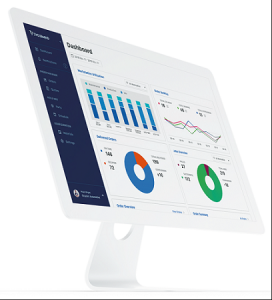 After spending five years providing order management systems to scale for some of the industry’s AM leaders, 3YOURMIND has finally moved its software solutions to a production environment with the launch of its Agile Manufacturing Execution System (MES) earlier this week at AMUG 2019. The software uses smart part prioritization, rapid scheduling, order tracking, and custom AM workflow creation to improve machine utilization and make production more efficient, and an Early Access Program (EAP) allowed the company to receive direct feedback on its Agile MES software from representatives at companies like EOS and Voestalpine. The next step will be working to finalize machine connectivity.
After spending five years providing order management systems to scale for some of the industry’s AM leaders, 3YOURMIND has finally moved its software solutions to a production environment with the launch of its Agile Manufacturing Execution System (MES) earlier this week at AMUG 2019. The software uses smart part prioritization, rapid scheduling, order tracking, and custom AM workflow creation to improve machine utilization and make production more efficient, and an Early Access Program (EAP) allowed the company to receive direct feedback on its Agile MES software from representatives at companies like EOS and Voestalpine. The next step will be working to finalize machine connectivity.
“For Agile Manufacturing, the Agile MES will need to both GET and PUSH data from all major AM machines and post-processing systems. We are already integrating the data from several vendors into our software and expect to support all major machines,” explained 3YOURMIND’s CEO Stephan Kühr. “Receiving and processing machine data allows us to provide the documentation that is needed for quality assurance and to increase the repeatability of additive manufacturing. Pushing data directly to machines will be the key to automating production.”
Sintratec Showcasing New SLS 3D Printer at RAPID + TCT
 A few months ago, Swiss SLS 3D printer manufacturer Sintratec introduced its scalable, modular Sintratec S2. Now, the company will be presenting the printer in the US for the first time next month at RAPID + TCT in Detroit, which will also be Sintratec’s first time attending the massive event. What makes the Sintratec S2 stand out is its closed-loop workflow, as the complete system covers every process with its three modules: the Laser Sintering Station (LSS), the Material Core Unit (MCU), and the Material Handling Station (MHS). The 3D printer offers quick material changes, a 4K camera for print monitoring, improved ergonomics, and effective heat distribution through its cylindrical printing area and ring lamps.
A few months ago, Swiss SLS 3D printer manufacturer Sintratec introduced its scalable, modular Sintratec S2. Now, the company will be presenting the printer in the US for the first time next month at RAPID + TCT in Detroit, which will also be Sintratec’s first time attending the massive event. What makes the Sintratec S2 stand out is its closed-loop workflow, as the complete system covers every process with its three modules: the Laser Sintering Station (LSS), the Material Core Unit (MCU), and the Material Handling Station (MHS). The 3D printer offers quick material changes, a 4K camera for print monitoring, improved ergonomics, and effective heat distribution through its cylindrical printing area and ring lamps.
“The Sintratec S2 will boost the design of applications and gives the user the opportunity to set foot in small series production as well. And that for an unusually attractive price-performance ratio,” said Sintratec CEO Dominik Solenicki.
“With the Sintratec S2 solution we will be opening new opportunities for companies of any size.”
The price for the Sintratec S2 starts at $39,900, and you can see it for yourself at Sintratec’s booth 1753 at RAPID + TCT from May 20-23.
Tiamet 3D Joins Ultimaker’s Material Alliance Program
 Last year, Dutch 3D printing specialist Tiamet 3D, founded in late 2014, worked with Finland-based Carbodeon to develop the first nanodiamond-enhanced 3D printing filaments, which went on the market in September. Now the company has joined Ultimaker as a partner in its Material Alliance Program. Together, the two will offer end-users simple one click downloads of Tiamet’s ULTRA Diamond material profile, which is now available on Ultimaker’s Cura software. This collaboration is formally backed by Tiamet’s manufacturing partner Mitsubishi Chemical Performance Polymers (MCPP Netherlands).
Last year, Dutch 3D printing specialist Tiamet 3D, founded in late 2014, worked with Finland-based Carbodeon to develop the first nanodiamond-enhanced 3D printing filaments, which went on the market in September. Now the company has joined Ultimaker as a partner in its Material Alliance Program. Together, the two will offer end-users simple one click downloads of Tiamet’s ULTRA Diamond material profile, which is now available on Ultimaker’s Cura software. This collaboration is formally backed by Tiamet’s manufacturing partner Mitsubishi Chemical Performance Polymers (MCPP Netherlands).
Reid Larson, the Director and Co-Founder of Tiamet 3D, told us about some of the highlighted specs of its ULTRA Diamond material, including no additional nozzle wear, 6300 mpa stiffness, low moisture absorption and friction, improved thermal conductivity, and twice “the temperature resistance of normal PLA, Annealed goes to 125C HDT.” You can purchase one kg of ULTRA Diamond filament for €59.
Sciaky Increasing Sales Efforts Through New Agreement
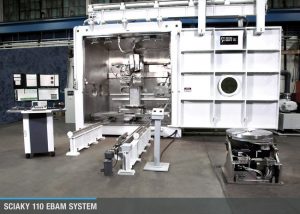 In an effort to increase the sales efforts of its Electron Beam Additive Manufacturing (EBAM) solutions in Australia, the Middle East, and New Zealand, Sciaky, Inc. has entered into an agreement with KTM Consultants, founded by metallurgist Trent Mackenzie in 2015. In terms of sheer work envelope, Sciaky’s massive EBAM systems are the industry’s most widely scalable metal 3D printing solution, able to produce parts ranging from 8 inches to 19 feet at gross deposition rates of up to 25 lbs of metal an hour. Additionally, its Interlayer Real-time Imaging and Sensing System (IRISS) is the metal 3D printing market’s only real-time adaptive control system capable of sensing and digitally self-adjusting its deposition.
In an effort to increase the sales efforts of its Electron Beam Additive Manufacturing (EBAM) solutions in Australia, the Middle East, and New Zealand, Sciaky, Inc. has entered into an agreement with KTM Consultants, founded by metallurgist Trent Mackenzie in 2015. In terms of sheer work envelope, Sciaky’s massive EBAM systems are the industry’s most widely scalable metal 3D printing solution, able to produce parts ranging from 8 inches to 19 feet at gross deposition rates of up to 25 lbs of metal an hour. Additionally, its Interlayer Real-time Imaging and Sensing System (IRISS) is the metal 3D printing market’s only real-time adaptive control system capable of sensing and digitally self-adjusting its deposition.
“I was immediately drawn to Sciaky’s EBAM technology because of its unique and robust capabilities. Industrial manufacturers of large metal parts need to explore the significant advantages that technologies like EBAM offer. It is truly a game-changer,” said Mackenzie.
Xometry Announces New Industry Certifications
 Digital manufacturing marketplace Xometry announced that it has just received ISO 9001:2015 and AS9100D certifications – some of the most rigorous, widely-recognized quality management designations in the industry. ISO 9001 helps organizations meet the needs and expectations of their customers in terms of quality management, while AS9100 meets customer demands in the exacting aerospace and defense industries. The company went through a major audit as part of the process, and its achievement definitely reflects how committed Xometry is to providing quality.
Digital manufacturing marketplace Xometry announced that it has just received ISO 9001:2015 and AS9100D certifications – some of the most rigorous, widely-recognized quality management designations in the industry. ISO 9001 helps organizations meet the needs and expectations of their customers in terms of quality management, while AS9100 meets customer demands in the exacting aerospace and defense industries. The company went through a major audit as part of the process, and its achievement definitely reflects how committed Xometry is to providing quality.
“We are thrilled to receive this designation. Our team members have a passion for providing great customer service while following the disciplines that give our customers peace of mind regarding on-time delivery, quality, and continuous improvement. It is yet another step towards achieving industry “best in class” status and being able to meet the expanded needs of our customers,” stated Xometry COO Peter Goguen.
nScrypt Develops Proprietary Method for 3D Printing Titanium
Florida manufacturer nScrypt, which develops high-precision Micro-Dispensing and Direct Digital Manufacturing equipment and solutions, is now focusing on repeatable 3D printing of metals for the medical, defense, and aerospace industries. The company has created a proprietary method for 3D printing titanium parts, which tests have shown display densities comparable to wrought parts. This method could easily work with other metals as well, such as copper, Inconel, and stainless steel, and nScrypt’s Factory in a Tool (FiT) systems can finish or polish areas with high tolerance features using its integrated precision nMill milling head. nScrypt’s Brandon Dickerson told us that the company expects to release more details on this later in 2019.
“The parts were printed with our SmartPump
Micro-Dispensing tool head, which runs on any of our systems,” Dickerson told 3DPrint.com. “The parts shown in the photos were printed on our DDM (Direct Digital Manufacturing) system, also known as our Factory in a Tool (FiT) system, which can run 5 tool heads at the same time, including our Micro-Dispensing, Material Extrusion, micro-milling, and pick-and-place tool heads. The parts were sintered after the build and the current densities are in the high 90% range. We expect our system to appeal to customers who want to do Direct Digital Manufacturing and need strong metal parts, but cannot build them with a powder bed system (for example, if the geometry would trap powder inside) or prefer not to use a powder bed system (for example, if they want a cleaner system).”
Zurich Opera House 3D Printing Props with German RepRap
Switzerland’s largest cultural institution, the Zurich Opera House, puts on over 300 performances a year, but the behind-the-scenes magic happens in the studios and workshops, where the props and costumes are made. The opera house uses the x400 3D printer from German RepRap, with assistance from Swiss reseller KVT- Fastening, to support its creative work by fabricating props and molds. This affords the institution more creativity and flexibility, as they can design objects to their exacting needs in 3D modeling programs, which also helps save on time and money. The opera house currently uses PLA, which is easy to handle, offers a variety of colors, and is flame retardant – very important in a theatrical setting.
“Often, the wishes and ideas of costume and stage designers are very diverse and sometimes extraordinary. It often happens that props are not available in the way designers have it in their minds. This is where the 3D printer is perfect for,” said Andreas Gatzka, director of theater sculpture at the Zurich Opera House.
“There are a lot of great benefits. Special wishes of stage and costume designers can be realized quickly as well as a short-term change of the objects, for example larger, smaller, longer, shorter, or whatever is needed.”
3D Printed Art Collection
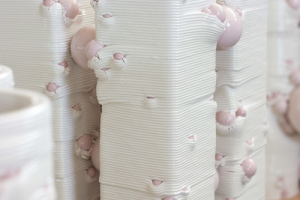 Artist Andrea Salvatori 3D printed the eye-catching pieces for his new collection, titled Ikebana Rock’n’Roll, using the Delta WASP 40100 Clay 3D printer – designed by WASP to be used by ceramic and clay artists. The collection just opened on stage at THE POOL NYC in Milan last week, and will be available to view until May 31st. With these 3D printed vases, Salvatori wanted to use “a miscellany of ceramic insertions” to mess with the high quality shapes 3D printing can achieve by adding asymmetry.
Artist Andrea Salvatori 3D printed the eye-catching pieces for his new collection, titled Ikebana Rock’n’Roll, using the Delta WASP 40100 Clay 3D printer – designed by WASP to be used by ceramic and clay artists. The collection just opened on stage at THE POOL NYC in Milan last week, and will be available to view until May 31st. With these 3D printed vases, Salvatori wanted to use “a miscellany of ceramic insertions” to mess with the high quality shapes 3D printing can achieve by adding asymmetry.
“The process of depositing the material and setting the spheres is a central theme in the Ikebana Rock’n’Roll collection, to the point of convincing Salvatori to name the works “Composition 40100”, as if they originated from a musical dialogue of the most varied tones. The artist upsets the algorithm reiterated slavishly by the machine with imperfect musical accents, the result from time to time of spontaneous actions and reasoned processes,” WASP wrote in a blog post.
“The ikebanes, proposed by Andrea Salvatori in the exhibition, transcend the experimental limits of an abstract investigation, representing a concrete territory in which 3D printing and ceramic art co-exist synergistically. The Master challenges the confrontation with the public, becoming also in this sector, precursor of a new genre in which WASP feels itself fully represented.”
Discuss these stories and other 3D printing topics at 3DPrintBoard.com or share your thoughts in the Facebook comments below.


